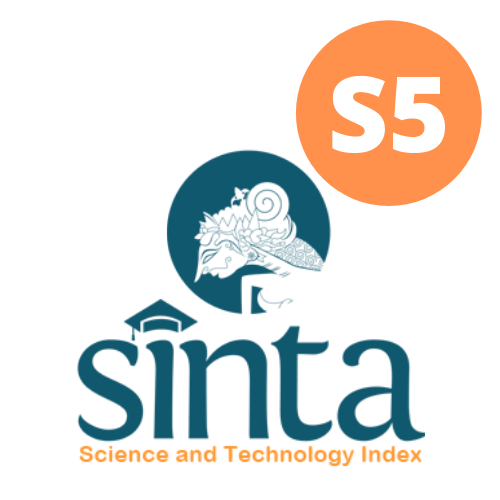تحليل عناصر المنهج التعليمي 2013 في مادة اللغة العربية على المستوي الابتدائي في إندونيسيا
Abstract
مستخلص البحث
المنهج هو التخطيط المرتب لتحقيق الأهداف المنشودة. المنهج التعليمي له تاريخ طويل في إندونيسيا قد يتميز بتغيير وجوده استمرار. وبهذا البحث يناقش الباحث عن سياسية الحكومة من خلال نظام الوزيرة (Permen KMA) كأساس في تطبيق هذا المنهج التعليمي 2013 في مادة اللغة العربية على المستوي الابتدائي بإندونيسيا. وأما ذلك، هناك العناصر الموجودة في هذا المنهج، وهي: 1) الأهداف 2) المحتوى، 3) وسائل التعليم، 4) طريقة التعليم 5) والتقويم. في هذا البحث يستخدم الباحث مدخل الدراسة المكتبية (Library Research) وهي البحث التي أجريت باستخدام الأدب (المكتبة)، يبحث عن المصادر المناسبة بالموضوع المبحوث في شكل الكتب، والسجلات، والمقالات، والدراسات السابقة. يستخدم المنهجية البحث النوعي بمدخل تحليلية ووصفية الذي يتم توجيهه إلى الدراسة المكتبية، هو على وصف البيان الذي يقدم به الخبراء السابقة. النتائج التي وجدت في هذا البحث، هي: 1) الأهداف في هذا المنهج التعليمي 2013 هي التركيز على تنمية قدرة الطلاب على جوانب المعارف، والموقف، والسلوك. أما بالنسبة المحتوى المرتب في هذا المنهج هو لدعمه في تحقيق الأهداف. في تحديد الهدف، يرجع إلى احتياجات الطلاب دائماً علاقتها بأهداف تعليم اللغة العرابية، وهي كوسيلة لدراسة الإسلام. 2) يخدم المنهج التعليمي 2013 المحتوى البسيط للمستوى الابتدائي. المواد المقدمة على هذا المستوى لا يزال "يذكر" أسماء الكائنات وما حولها. ويشمل فيه الاعتراف، الآلات المدرسية، والوظائف، والعنوان، وأفراد الأسرة، والمنزل، والحديقة، وفي المدرسة، وفي المعمل، وفي المكتبة، وفي التعاون، والساعة، والأنشطة اليومية، والعمل، والمنزل. ثم في إختيار المحتوى لا يمكن فصلها عن أهداف تعليم اللغة العربية. على هذا المستوي. 3) وأما بالنسبة طرائق التعليم المذكورة في المنهج التعليمي 2013 في مادة اللغة العرابية على المستوي الابتدائية، هي طريقة القراءة، وطريقة إعطاء التمرينات، وطريقة السؤال والإجابة، وطريقة المترادفة، وطريقة ترجمة الكلمات البسيطة. 4) وفيما يتعلق بوسائل التعليم التي تظهر في هذا المنهج التعليمي هي أداة أو قوائم الجرد المتعلقة بالمواد التعليمية مثل الصور، والبطاقة، والورق، والورق المقوى، إلخ. والتكنولوجيا الذي يستخدم أيضا كوسيلة التعليم، من أجل دعم تحقيق أهداف مثل السبورة، والحاسوب، والشريط، والمزياع، والشاشة، وما إلى ذلك. 5) التقويم في المنهج التعليمي 2013 ثابتة في تقييم كفاءة الطلاب في تحقيق الأهداف التي وضعت على جوانب المعارف، والمواقف، والسلوك.
Copyright
Authors published in this journal agree to the following terms:
1. The copyright of each article is retained by the author (s).
2. The author grants the journal the first publication rights with the work simultaneously licensed under the Creative Commons Attribution-ShareAlike 4.0 International, allowing others to share the work with an acknowledgment of authorship and the initial publication in this journal.
3. The author may enter into separate additional contractual agreements for the non-distribution of published journal versions of the work (for example: posting them to institutional repositories or publishing them in a book), with acknowledgment of their initial publication in this journal.
4. Author are permitted and encouraged to post their work online (for example: in the Institutional Repository or on their website) before and during the subsmission process, as this can lead to productive axchanges, as well as erlier and larger citations of published work.
5. Articels and all related material published are distributed under a Creative Commons Atrribution-ShareAlike 4.0 International License.
You are free to:
- Share — copy and redistribute the material in any medium or format for any purpose, even commercially.
- Adapt — remix, transform, and build upon the material for any purpose, even commercially.
- The licensor cannot revoke these freedoms as long as you follow the license terms.
Under the following terms:
- Attribution — You must give appropriate credit , provide a link to the license, and indicate if changes were made . You may do so in any reasonable manner, but not in any way that suggests the licensor endorses you or your use.
- ShareAlike — If you remix, transform, or build upon the material, you must distribute your contributions under the same license as the original.
- No additional restrictions — You may not apply legal terms or technological measures that legally restrict others from doing anything the license permits.
Notices:
You do not have to comply with the license for elements of the material in the public domain or where your use is permitted by an applicable exception or limitation .
No warranties are given. The license may not give you all of the permissions necessary for your intended use. For example, other rights such as publicity, privacy, or moral rights may limit how you use the material.








